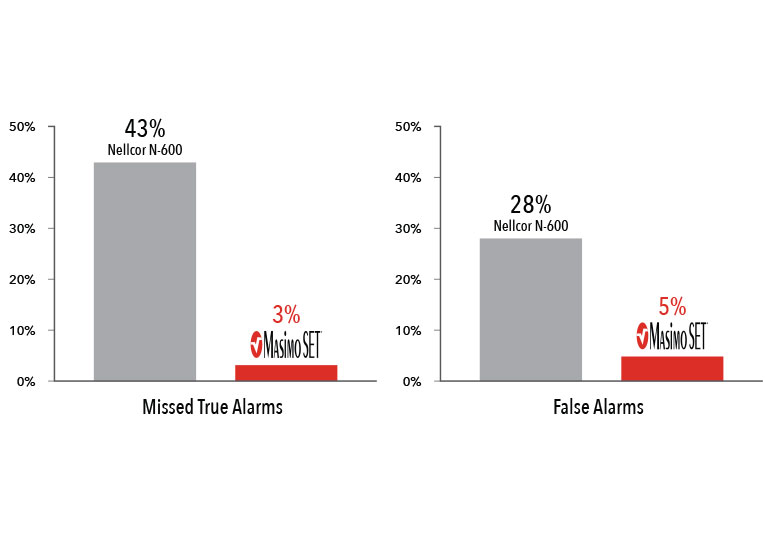Masimo SET®: Clinically Proven
The accuracy and reliability of Masimo SET® pulse oximetry have been studied in challenging conditions
Home / Masimo SET®: Clinically Proven
Masimo SET®: Clinically Proven
Over 100 independent and objective studies have shown that Masimo SET® outperforms other pulse oximetry technologies.1
- On a post-surgical unit it was found that:
- Rescue calls and ICU transfers were reduced by 65% and 48%, respectively, after the implementation of continuous surveillance monitoring with Masimo SET®.2
- Over five years, clinicians achieved their goal of zero preventable deaths or brain damage due to opioids.3
- Over ten years, clinicians maintained a 50% reduction in unplanned transfers and a 60% reduction in rescue events, despite increases in patient acuity and occupancy.4
- In a PACU, Masimo SET® had a greater than 50% reduction in false alarms compared to other pulse oximetry technology.5
- In a study of 122,738 infants, critical congenital heart disease (CCHD) screening sensitivity increased from 77% to 93% with the combined use of Masimo SET® and clinical assessment.6
- In a study of 39,821 infants, CCHD screening sensitivity increased from 63% with physical exam alone to 83% with physical exam and Masimo SET® pulse oximetry.7
- In two NICU settings, Masimo SET®, coupled with changes in clinical practice, showed significantly reduced rates of severe retinopathy of prematurity (ROP) and decreased the need for laser treatment.8,9
- Researchers showed time to reliable oxygen saturation readings during neonatal resuscitation was approximately 50 seconds faster using Masimo SET® than using other pulse oximetry technologies.10
“I saw and was conquered. I was not able to defeat the Masimo SET® pulse oximeter using all the motion and low pulse tricks I know. This technology is most impressive and should be available in all oximeters.”
John Severinghaus, M.D.
Professor of Anesthesiology, Emeritus University of California, San Francisco
The Performance of Masimo SET®
The Performance of Masimo SET®
CCHD Screening
Improved Critical Congenital Heart Disease Screening
Sensitivity vs. Clinical Assessment Alone

- When combined with clinical assessment, Masimo SET® improved critical congenital heart disease (CCHD) screening sensitivity to 93%6
Retinopathy of Prematurity
Severe Retinopathy of Prematurity Rate

- Masimo SET®, coupled with changes in clinical practice, led to a significant reduction in rates of severe retinopathy of prematurity (ROP)8
Performance During Motion and Low Perfusion

- Masimo SET® had 3% missed true alarms and 5% false alarms versus 43% and 28%, respectively, using competitor technology11*
*Results shown are calculated by combining sensitivity and specificity outcomes of machine-generated and volunteer-generated motion.
Learn More About Masimo SET®
Learn More About Masimo SET®
References:
- 1.
Published clinical studies on pulse oximetry and the benefits of Masimo SET® can be found on our website at http://www.masimo.com. Comparative studies include independent and objective studies which are comprised of abstracts presented at scientific meetings and peer-reviewed journal articles.
- 2.
Taenzer AH et al. Impact of pulse oximetry surveillance on rescue events and intensive care unit transfers: a before-and-after concurrence study. Anesthesiology. 2010:112(2):282-287.
- 3.
Taenzer A et al. Postoperative Monitoring – The Dartmouth Experience. Anesthesia Patient Safety Foundation Newsletter. Spring-Summer 2012.
- 4.
McGrath S et al. Surveillance Monitoring Management for General Care Units: Strategy, Design, and Implementation. The Joint Commission Journal on Quality and Patient Safety. 2016 Jul;42(7):293-302.
- 5.
Malviya S et al. False Alarms and Sensitivity of Conventional Pulse Oximetry Versus the Masimo SET® Technology in the Pediatric Postanesthesia Care Unit. Anesth Analg 2000; 90(6):1336-1340.
- 6.
Zhao et al. Pulse oximetry with clinical assessment to screen for congenital heart disease in neonates in China: a prospective study. Lancet 2014 Aug 30;384(9945):747-54.
- 7.
de-Wahl Granelli A et al. Impact of pulse oximetry screening on the detection of duct dependent congenital heart disease: a Swedish prospective screening study in 39,821 newborns. BMJ 2009;338:a3037.
- 8.
Castillo et al. Prevention of retinopathy of prematurity in preterm infants through changes in clinical practice and SpO2 Technology. Acta Paediatr. 2011 Feb;100(2):188-92.
- 9.
Sola et al. Can changes in clinical practice decrease the incidence of severe retinopathy of prematurity in very low birth weight infants? Pediatrics 2003;111(2):339-345.
- 10.
Baquero H et al. Avoiding Hyperoxemia during Neonatal Resuscitation: Time to Response of Different SpO2 Monitors. Acta Paediatr. 2011 Apr;100(4):515-8.
- 11.
Shah et al. Performance of Three New-Generation Pulse Oximeters during Motion and Low Perfusion in Volunteers. J Clin Anesth. 2012;24(5):385-91.
RESOURCES
Video
Caution: Federal (USA) law restricts this device to sale by or on the order of a physician. See instructions for use for full prescribing information, including indications, contraindications, warnings, and precautions.
PLCO-002404/PLM-11611A-1218





